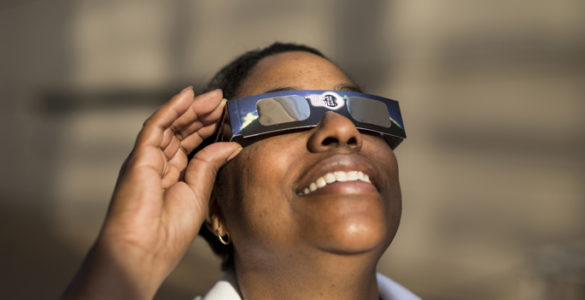
On Aug. 21 millions of people will look skyward as day turns into night when the first coast-to-coast solar eclipse in nearly a century passes over Middle Tennessee.
Nashville is the largest city in the path of the eclipse, and specialists at the Vanderbilt Eye Institute want to ensure that eclipse watchers keep an eye on safety while viewing the astronomical event.
“This is historical and I would encourage everyone to see it,” said Nathan Podoll, M.D., assistant professor of Ophthalmology and Visual Sciences at Vanderbilt University Medical Center (VUMC). “The entire country will be able to see at least a partial eclipse, but Nashville is in the direct path for the total solar eclipse.
“It’s incredibly exciting and something you should participate in and enjoy, but you should do it safely with the proper filters for your eyes,” he stressed.
A solar eclipse occurs when the moon blocks the view of the sun. For a few minutes on Aug. 21 the moon will orbit perfectly between the earth and the sun causing total darkness to fall over 14 states, while others outside the path of the total eclipse will see a partial solar eclipse.
According to NASA, about 325 million people in the country will be able to view some portion of the eclipse.
Podoll said the most impressive feature during a total solar eclipse is the solar corona, which is the outer atmosphere of the sun. The corona consists of gas glowing at a temperature of 1-to-2 million degrees Celsius. Although the corona itself doesn’t produce enough radiation to harm the retina, the seconds before and after the total eclipse can produce enough light intensity to be harmful.
It is that aspect of the event that is most worrisome to eye care specialists, said Podoll, who urges viewers heed the warning: Never look directly at the sun.
“There are risks of viewing the eclipse without any protection,” warned Podoll. “Normally if you look directly at the sun, the natural response is to squint, shield your eyes, blink or turn away.
“The concern with the eclipse is that when it is in the partial phase, the natural reflex to shy away from looking at the sun is reduced, and that is dangerous because of the possibility of developing solar retinopathy, which can occur without the person knowing it,” he said.
In addition, the retina has no pain receptors so damage can occur before someone realizes, Podoll added. In most cases retinal damage will result in blurred vision or the presence of blind spots. An eye care specialist will be able to determine the level of damage upon examination, he said.
Podoll offers a few eyewear tips for safe eclipse viewing:
- Make sure to wear proper protective eyewear — eclipse glasses filter out harmful rays and make it safe to view all phases of the eclipse.
- Make sure the lenses are made of black polymer material. HINT: while wearing a pair of undamaged glasses (ones that are not scratched, torn or with holes) you shouldn’t be able to see anything except the mild glow of the sun when looking toward the sun.
- Proper protective eyewear can be worn OVER regular prescription glasses
- Discard lens if light penetrates through tiny pinholes or scratches have developed
- A shade No. 14 welding glass is suitable.
There are alternative methods to indirectly view the partially eclipsed sun. NASA suggests the following: cross the outstretched, slightly open fingers of one hand over the outstretched, slightly open fingers of the other. With your back to the sun, look at your hands’ shadow on the ground. The little spaces between your fingers will project a grid of small images on the ground, showing the sun as a crescent during the partial phases of the eclipse.
Other options include: Craft a pinhole viewer to project the image onto another surface. Place a pinhole or small opening in a card. Other suggested ready-made pinholes include a colander, strainers, pegboards or anything with really small holes. Hold the object between the sun and a white surface, like a piece of paper or the sidewalk, to see an image of the sun on the screen.
NEVER view an eclipse:
- With the naked eye EXCEPT during totality when the Sun is completely covered by the Moon. You MUST use proper eye protection (e.g., solar eclipse glasses) to view the PARTIAL solar eclipse phase, which lasts for approximately 1.5 hours before totality and after totality. During the TOTAL solar eclipse, when the Sun is completely obscured by the Moon, one MUST REMOVE the solar glasses and view naked-eye. The corona, which is safe to observe naked-eye, cannot be observed with solar glasses as it is only about as bright as a full moon. Those outside the path of totality will never see the Moon completely cover the Sun and will have to wear proper eye protection for the entire solar eclipse.
- With darkened sunglasses
- Looking through a window in a home or car
- Via smoked glass
- Using exposed film
- Through an unfiltered telescope, binocular or camera lens
- With medical X-ray film with images on them
- Using a sun filter on a telescope. One can observe the PARTIAL phase of the solar eclipse with a telescope that is equipped with the proper solar filter at the front end so that the light is filtered before it enters the telescope. It is NOT recommended to view the TOTAL solar eclipse telescopically as this requires removal of the solar filter and puts one at risk of serious eye damage because the exact moment when the Sun begins to re-emerge from behind the Moon is not known.












